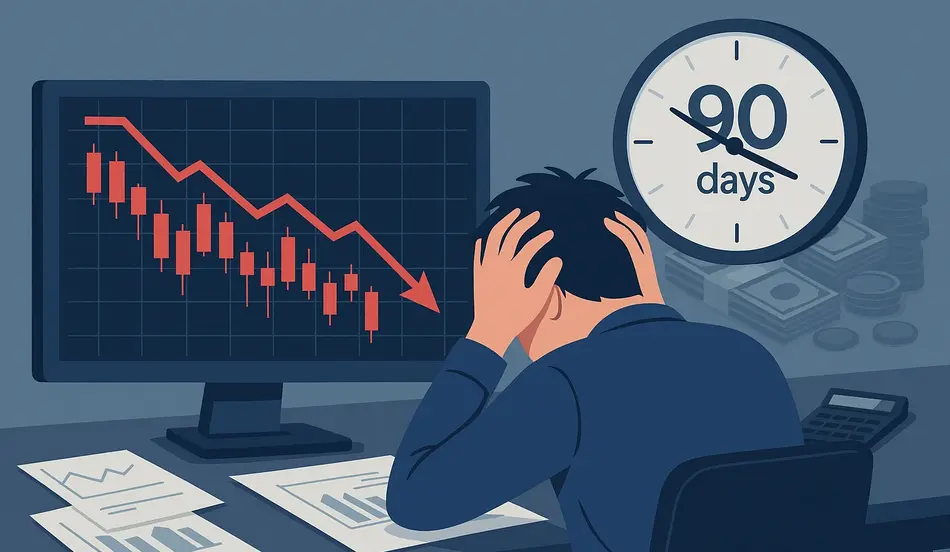There’s a saying in trading circles: “90% of traders lose 90% of their capital in 90 days.” While the numbers may vary depending on the study, the reality behind this statistic is painfully true for many new traders. Markets are challenging, unpredictable, and unforgiving to those who enter unprepared.
But why do so many fail so quickly? And more importantly—what can be done to survive and thrive beyond the first few months?
This article explores the common pitfalls of retail traders, the myths that derail progress, and the habits that separate those who quit from those who last.
The Harsh Reality: Why Most Traders Fail Fast
1. Lack of Risk Management
The single biggest reason traders fail is poor risk management. Many enter trades thinking only about how much money they could make, not how much they could lose. Professionals, on the other hand, define their risk first. They decide before entering a trade how much they’re willing to lose if things go wrong.
Without this discipline, losses snowball—and capital vanishes.
2. Overconfidence and “This Time Is Different” Thinking
A classic mistake is believing a trade is “special.” The moment a trader says “This time is different,” it usually leads to their largest loss. Markets punish emotional certainty. Consistency—not conviction—is what protects accounts.
3. Trading Too Big, Too Soon
Starting with oversized positions is a fast track to blowing up an account. Traders mistakenly believe bigger size equals faster profits, when in reality, it only accelerates risk. Successful traders start small—sometimes with just a single contract or minimal share size—until they find a system that works.
4. Believing in Market Myths
A persistent myth is that “market makers hunt stop losses.” In reality, most stop orders are stored on traders’ own platforms and are never visible to others. What often happens is that traders place stops at predictable levels (like round numbers—$50, $100, $1,000), and the natural market movement triggers them. It’s not conspiracy; it’s psychology.
5. Emotional Decision-Making
Money is emotional. Telling traders “don’t be emotional” is unrealistic—everyone reacts when their hard-earned money is at stake. The solution isn’t to eliminate emotion but to manage it by having a process: pre-planned exits, partial positions, and rules that stop emotions from taking over in the heat of the moment.
Lessons from Traders Who Survive Beyond 90 Days
Start Small
Trade in tiny amounts until the mechanics and decision-making become second nature. Losing $50 is a lesson; losing $5,000 is often a career ender.
Define Risk Every Time
Know the maximum you are willing to lose before clicking “buy.” If that number makes you uncomfortable, reduce the trade size.
Build a Process, Not Just Trades
Consistency is key. Develop a routine, keep a journal, and review what went right and wrong. Over time, this builds discipline.
Stay Humble
The market is bigger than any one person. Confidence matters, but humility keeps traders from overexposing themselves.
Find a Community or Mentor
One advantage traders once had in physical trading pits was constant feedback—debates, challenges, and peer learning. Today, retail traders can replicate this through online communities, trading forums, or structured mentorship.
The Role of Work Ethic in Longevity
Beyond charts and strategies, one timeless trait separates survivors from quitters: work ethic. Trading isn’t just clicking buttons—it’s about study, review, patience, and discipline. Just as in any career, consistent effort creates the conditions for “luck” to appear.
Key Takeaway
Most traders lose early not because trading is impossible, but because they rush in without risk management, discipline, or process. By starting small, focusing on survival, and learning continuously, traders can beat the 90-day statistic and build a career with staying power.
FAQs
Q1: Is it true that 90% of traders lose in 90 days?
While the exact figure varies, the statistic reflects a real truth: most retail traders fail quickly due to lack of preparation and discipline.
Q2: How much money should a beginner risk per trade?
Many professionals recommend risking no more than 1–2% of your account on a single trade. This helps preserve capital during inevitable losing streaks.
Q3: Are stop losses really “hunted”?
Not in the way many traders believe. Markets often gravitate toward obvious price levels, and traders tend to cluster stops at round numbers. It’s not manipulation, but natural market behavior.
Q4: Can I be profitable trading from home?
Yes, but success requires discipline, a structured system, continuous learning, and emotional control. Many retail traders succeed long-term by treating trading like a business, not a gamble.
Q5: What’s the most important skill for trading longevity?
Risk management. Strategies may differ, but protecting capital is universal across all successful traders.
Final Thoughts
Trading isn’t about quick wins—it’s about survival. If you can stay in the game beyond those critical first 90 days, your odds of long-term success increase dramatically. Approach trading with humility, discipline, and consistency, and you’ll separate yourself from the majority who quit too soon.






